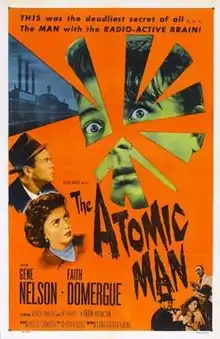Timeslip (1955 film)
Timeslip (known as The Atomic Man in the United States) is a 1955 British black-and-white science fiction film directed by Ken Hughes and starring Gene Nelson and Faith Domergue. Produced by Alec C. Snowden, it is based on a script by Charles Eric Maine, who also wrote Spaceways.[1]
| Timeslip | |
|---|---|
 U.S. theatrical release poster | |
| Directed by | Ken Hughes |
| Produced by | Alec C. Snowden executive Nat Cohen Stuart Levy |
| Written by | Charles Eric Maine |
| Starring | Gene Nelson |
| Cinematography | A. T. Dinsdale |
| Edited by | Geoffrey Muller |
Production company | Anglo Guild Productions Todon Productions (uncredited) |
| Distributed by | Anglo-Amalgamated (UK) Allied Artists Pictures (US) |
Release date | November 1955 (UK) 4 March 1956 |
Running time | 93 minutes (UK) 76 minutes (US) |
| Country | United Kingdom |
| Language | English |
In the UK, the film was distributed by Anglo-Amalgamated. In 1956 the film was shortened from 93 minutes to 76 minutes and distributed in the U.S. by Allied Artists Pictures in some areas as a double feature with Invasion of the Body Snatchers.
Plot
An injured man is pulled from the Thames. He has been shot in the back and is barely alive. The science correspondent of an illustrated magazine recognises him as a nuclear physicist. But the physicist is alive and well and working at his lab. When the injured man is photographed his pictures shows a strange glow surrounding him and when he recovers enough to be questioned his answers make no sense.
The correspondent and his photographer girlfriend try to solve the puzzle and in doing so uncover international industrial espionage and a terrible threat to the atomic research institute.
Cast
- Gene Nelson as Mike Delaney
- Faith Domergue as Jill Robowski
- Peter Arne as Dr. Stephen Rayner/Jarvis
- Joseph Tomelty as Detective Inspector Cleary
- Donald Gray as Robert Maitland
- Vic Perry as Emmanuel Vasquo
- Paul Hardtmuth as Dr. Bressler
- Martin Wyldeck as Dr. Preston
- Leonard Williams as Detective Sergeant Haines
- Charles Hawtrey as Office boy (uncredited)
Production
The film was partially funded by its UK distributor, Anglo-Amalgamated.[2] It was a production of Todon Productions the American company although they are not credited.[3] Star Gene Nelson had been in two musicals, So This is Paris and Oklahoma! and this was his first serious dramatic lead.[4] He was reportedly cast after Tony Owen of Todon saw Nelson on an episode of Studio One.[5]
Filming started in England on 4 February 1955. It was shot at Merton Park Studios.[6]
The Isotope Man
Eric Main turned the script into a novel, The Isotope Man, published in 1957. It would be the first of three novels about reporter Mike Delaney. The New York Times called the novel "fairly crude and preposterous but lively enough".[7] The Los Angeles Times called it "near perfect entertainment for the radioactive age."[8]
Critical reception
TV Guide called it a "dumb movie with an interesting premise";[9] and AllMovie similarly thought its "absolutely fascinating premise" unfortunately translated into "lack of imagination in the script"; but from an able cast, Faith Domergue was "especially welcome", and the reviewer concluded "The budget is clearly low, but (Ken) Hughes does well with what he has."[10]
References
- TIMESLIP Monthly Film Bulletin; London Vol. 22, Iss. 252, (Jan 1, 1955): 170.
- Vagg, Stephen (14 November 2020). "Ken Hughes Forgotten Auteur". Filmink.
- Of Local Origin New York Times 27 Jan 1955: 17.
- Thomas M. Pryor (20 January 1955). "Metro Will Film Graziano Story: Studio Buys Biography of Middleweight Ex-Champion Who Turned to Acting;". New York Times. p. 35.
- Gene Nelson Goes to England to Enact American Reporter Hopper, Hedda. Chicago Daily Tribune 25 Jan 1955: a6.
- "Hollywood Production Pulse". Variety. 16 February 1955. p. 15.
- Criminals at Large By ANTHONY BOUCHER. New York Times 2 June 1957: 250.
- THE BOOK REPORT Kirsch, Robert R. Los Angeles Times 4 June 1957: B5.
- "The Atomic Man". TV Guide.
- "The Atomic Man (1955) – Ken Hughes | Review". AllMovie.
Bibliography
- Warren, Bill. Keep Watching the Skies: American Science Fiction Films of the Fifties, 21st Century Edition. Jefferson, North Carolina: McFarland & Company, 2009 (First Edition 1982). ISBN 0-89950-032-3.
External links
- Timeslip at IMDb
- Timeslip at BFI
- Timeslip at Reel Streets
- Timeslip at Letterbox DVD
- Complete film at Internet Archive
